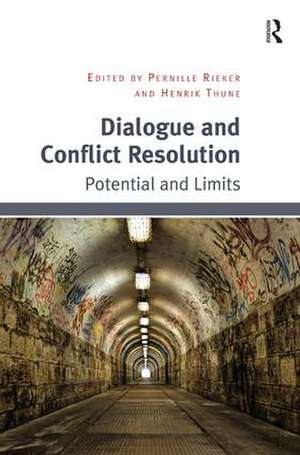Dialogue and Conflict Resolution: Potential and Limits
Autor Pernille Rieker, Henrik Thuneen Limba Engleză Hardback – 28 iun 2015
| Toate formatele și edițiile | Preț | Express |
|---|---|---|
| Paperback (1) | 241.15 lei 6-8 săpt. | |
| Taylor & Francis – 16 iun 2017 | 241.15 lei 6-8 săpt. | |
| Hardback (1) | 765.40 lei 6-8 săpt. | |
| Taylor & Francis – 28 iun 2015 | 765.40 lei 6-8 săpt. |
Preț: 765.40 lei
Preț vechi: 1028.13 lei
-26% Nou
Puncte Express: 1148
Preț estimativ în valută:
146.45€ • 152.93$ • 120.94£
146.45€ • 152.93$ • 120.94£
Carte tipărită la comandă
Livrare economică 16-30 aprilie
Preluare comenzi: 021 569.72.76
Specificații
ISBN-13: 9781472438836
ISBN-10: 1472438833
Pagini: 246
Dimensiuni: 156 x 234 mm
Greutate: 0.52 kg
Ediția:1
Editura: Taylor & Francis
Colecția Routledge
Locul publicării:Oxford, United Kingdom
ISBN-10: 1472438833
Pagini: 246
Dimensiuni: 156 x 234 mm
Greutate: 0.52 kg
Ediția:1
Editura: Taylor & Francis
Colecția Routledge
Locul publicării:Oxford, United Kingdom
Notă biografică
Pernille Rieker is a Senior Researcher at the Norwegian Institute of International Affairs (NUPI). She holds a doctoral degree from 2004 from the University of Oslo. Her research interests are related to international security, European integration, regional security and external governance as well as national foreign and security policy with a special focus on the Nordic countries and France. From 2005 to 2009 Rieker headed the Department of International Politics at NUPI. She has also worked as a senior advisor at NordForsk (2009-2010). Henrik Thune is a Senior Researcher at the Norwegian Institute of International Affairs (NUPI) and head of its Middle East Programme. He holds PhD and Masters degrees in international relations from the University of Oslo and the London School of Economics and Political Science. Thune has served five years as a diplomat in the Norwegian Ministry of Foreign Affairs, and has lengthy experience of work with peace and reconciliation processes. From 2009 to 2012 he was project manager in the Secretariat of the Norwegian Foreign Minister. Thune is currently conducting research on inter-state relations in the Middle East and Norwegian foreign policy.
Recenzii
’Dialogue is a being-in-the-world between assimilation on the one hand, and war on the other. The authors rightly stress how it is not for the immature. It requires sang froid, self-control, patience and tenacity. It is an idea and a practice that deserves the rich and timely celebration on display here.’ Iver Neumann, London School of Economics, UK ’Today, dialogue is heralded as the main currency of statecraft, diplomacy, negotiation, mediation and peacebuilding. Yet what exactly it is and isn't, when it works, when it backfires, and how to employ it most effectively in the geopolitical context is still in question. This book provides answers. Informed by compelling case studies and analyses by renowned experts, it sharpens our understanding of the concept and practice of dialogue. It will be essential reading for diplomats, scholars and students of peace, conflict and international affairs for many years to come.’ Peter Coleman, Columbia University, USA
Cuprins
Chapter 1 Introduction, PernilleRieker; Chapter 2 Diplomacy and Dialogue, Ole JacobSending; Chapter 3 The Dysfunctions of Non-party Conflict Diplomacy, HenrikThune, FridaNome; Chapter 4 Dialogue in a World of Emotional Politics, PaulSaurette, HenrikThune; Chapter 5 What Makes Dialogue and Diplomacy Work or Not? Russia – Georgia and Russia – Ukraine, Jakub M.Godzimirski; Chapter 6 Nuclear Diplomacy, SverreLodgaard; Chapter 7 Libya, MålfridBraut-Hegghammer, PernilleRieker; Chapter 8 Peace Dialogue, the Afghan Case 2001–2014, MichaelSemple; Chapter 9 The Attempts of Dialogue in Sudan, JohnAshworth; Chapter 10 Dialogue as Tool for Addressing Religious Tensions, GeorgesFahmi; Chapter 11 Conclusions, PernilleRieker, HenrikThune;
Descriere
Does dialogue really resolve conflicts? In this unique volume international experts critically assess the political role of dialogue, addressing its potential and limitations. Bringing fascinating insights to bear, they examine the theoretical underpinnings and conceptual boundaries of dialogue as a tool for conflict resolution. Major recent crises are considered and the conflict resolution attempts discussed. Using these cases the contributors explore in depth the nature of the dialogue between the actors, the extent to which it worked and what determined its impact.
